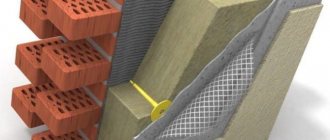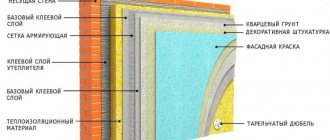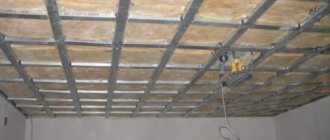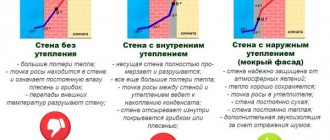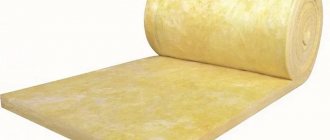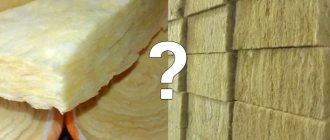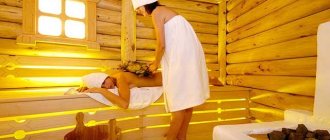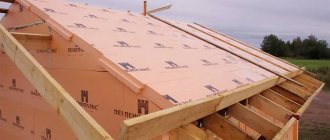Brick is a classic building material designed to last for decades. The thermal conductivity of brick walls depends on their thickness - the number of rows of masonry.
If a brick wall freezes in the first winter after building a brick house, this means that the construction technology was violated or the thickness of the house wall is insufficient. In this case, it is necessary to solve the problem of thermal insulation of brick walls from the inside.
External thermal insulation should be a priority, but its installation is not always possible. Let's look at how to insulate a brick house from the inside with mineral wool, which one is better to use, and how to properly carry out the installation of thermal insulation.
About insulating brick walls
Human activity is associated with a large release of heat and moisture. Heat radiates from the body, from household appliances. Moisture is released when breathing, cooking, using water for hygiene, washing dishes, and watering flowers. And the warmer the air, the better it retains moisture.
If the brick walls are not insulated enough, then when the heated, humid air cools, condensation will form on them. This will lead to the growth of fungus and the appearance of dark spots on the surface of walls and ceilings.
Mold spores are harmful to human health by entering the respiratory system and causing asthma or allergic reactions. In addition, mold has a destructive effect on the materials from which the walls are built and irreversibly damages the finish.
Before insulating the walls of a brick house from the inside, it is advisable to understand how this will affect the condition of the external walls and the indoor microclimate.
Specifications
Stone wool has a number of advantages compared to other types of insulation, which determine the scope of its use and the variety of places of application.
Description, types and features of production
Stone wool is produced, as already written above, from melts of various rocks. The most common type of stone wool is a material made from basalt; such insulation is also called “basalt wool”.
Stone wool is made in special furnaces in which natural rocks of mountainous, volcanic origin or basalt are melted at high temperatures.
The rock in a liquid state is drawn into fibers, to which binding components are added, after which the threads (fibers) are treated with special solutions that improve the technical characteristics of the resulting product.
After this, the threads are once again thermally treated, resulting in their polycondensation and the formation of insulation in the given geometric dimensions.
When forming stone wool slabs, resins based on phenol and formaldehyde are used.
Types of stone wool
Depending on the rigidity of the resulting insulation, basalt wool is classified as:
- Soft.
- Medium hardness.
- Tough.
The soft type of stone wool is made from fibers of the smallest thickness, which, when forming a slab, create a large number of air cavities that determine the product’s ability to retain heat.
This type of insulation is prone to destruction under the influence of external mechanical loads, so it is used in the construction of roofs, ceilings, floors and other building structures, which are covered with other materials during finishing.
Soft stone wool in rolls is used to insulate roofs and ceilings
The material is of medium hardness, made from thicker and correspondingly stiffer fibers, which allows it to be used for insulating facades, engineering structures (ventilation and cable ducts, heating mains), as well as other types of work (sound and fire safety) at similar facilities.
A hard type of stone wool, used in places where there are significant mechanical loads. Products of this type are laid under concrete screed and plaster directly on their surface with the installation of a reinforcing layer.
Stone wool is produced in the form of slabs (medium hardness and hard type) and rolls (soft type), as well as special cylinders used for thermal insulation of pipelines.
Rigid stone wool slabs are used to insulate facades.
Main technical characteristics
The characteristics that determine the physical properties of stone wool are:
- Thermal conductivity. The ability to transmit heat through its surface. The thermal conductivity coefficient for this type of insulation is from 0.032 to 0.048 W/(m*K), depending on the type and raw materials used.
- Hydrophobicity. Ability to absorb moisture. For this material, this figure is less than 2 percent of the volume of the product, which indicates that stone wool practically does not absorb water and can be used in rooms with a damp environment (bathrooms and showers, kitchens and bath rooms, as well as basements and exterior finishing).
- Vapor permeability. The ability to pass substances in a vapor state. The vapor permeability coefficient for stone wool is 0.3 mg/(m*h*Pa). When water vapor penetrates the surface of the insulation, condensation does not form and moisture is not absorbed into the structure of the material.
- Fire resistance. Ability to resist flame spread. Stone wool is a non-flammable material that does not support combustion. The material is able to withstand high temperatures, above 1000 * C, without melting and preventing the spread of fire.
- Soundproofing. Stone wool is a good sound insulator that can dampen sound waves.
- Strength. Due to the fact that the insulation is made from a large number of threads, even soft-type products have a certain margin of strength, while medium-hard and hard ones can withstand significant external mechanical loads.
- Resistance to chemically active substances and biological organisms. This material is chemically passive. It does not enter into chemical reactions with materials (wood, metal, plastic and others) and is not susceptible to the formation of microorganisms and mold, and is also not affected by rodents.
- Environmental Safety. Although in the production of stone wool resins based on phenol and formaldehyde are used, but since their quantity is insignificant, then this material is considered environmentally friendly, moreover, during the production process, these substances are neutralized.
- Geometric dimensions. The thickness of the sheets (roll) is a multiple of 50.0 mm, while this value is the minimum possible, and the maximum size produced is 200.0 mm. When selling stone wool in rolls, its length can be 10.0 m (depending on thickness) and width 1.2 meters. When sold in slabs, the size is 1000x1200 mm.
Features of internal insulation
It is clear that insulating a brick house from the inside is not the best solution. However, you should resort to it if:
- The building is an architectural monument and the appearance of its facade should not be changed.
- The walls of an apartment in a multi-story building freeze. According to current standards, it is forbidden to install structures that change the appearance of the building.
- The buildings are located close to each other, which makes it impossible to carry out work on insulating the external walls.
- Exterior brick houses made of expensive facing bricks are a pity to cover with new finishing, and laying a new outer layer of decorative brick after installing the insulation requires additional serious financial investments.
The disadvantages of insulating internal brick walls include the reduction of space in the room due to the installation of insulation and a base for finishing. The thickness of the insulating “pie” is usually at least 10 cm.
When installing thermal insulation inside the house, it is important to remember that insulating the internal surfaces of brick walls is fraught with the formation of condensation, which should not be allowed.
Using drywall as insulation
Drywall, or gypsum board, is a thin sheet of gypsum, lined on both sides with layers of thick paper. Drywall has good strength and a perfectly flat surface, which is convenient to paint or wallpaper. It is easily mounted on prepared guides; you can cut the sheet into pieces of the required size and shape with a regular mounting knife.
All this makes gypsum board one of the most popular finishing materials. Can it also serve as insulation? By itself, no. Its thermal conductivity is determined by the thermal conductivity of gypsum, it is only half that of brick and ten times higher than that of mineral wool or other thermal insulation materials. In order for drywall to effectively retain heat, its layer must be several tens of centimeters.
However, the structure of the guides, which are mounted to install gypsum board on walls or ceilings, can be effectively used to place real insulation in it - sheets of mineral wool or foamed plastics. The surface of the plasterboard sheet will cover the thermal insulation from mechanical influences.
Where to place thermal insulation?
Insulation of buildings should be carried out correctly from the outside, otherwise condensation cannot be avoided upon contact with a cold front (dew point). Let's consider three types of brick walls:
- There is no thermal insulation . The dew point is located in the thickness of the brick wall, so it accumulates moisture during the winter months, dries out and eventually collapses.
- Thermal insulation is located on the room side . As the brick wall freezes, the dew point moves towards the room, towards the inner surface of the enclosing structure. As a result, moisture condenses between the heat insulator and the brick wall. To avoid the appearance of moisture in the wall, it is necessary to ensure effective ventilation of the room .
- The insulation layer is laid on the street side . The wall does not freeze, so it remains dry and freely allows water vapor to pass through. It is important that there is a ventilation gap between the insulation layer and the brickwork to remove moisture from the room.
Arrangement of sheathing
Those who carry out the insulation of the facade on their own, the need to install the sheathing is often linked to the fastening of mineral wool to the wall. But that's not true. The mats adhere perfectly to the wall surface with glue and dowels. So, before painting the facade, it is enough to strengthen the surface of the mats with fiberglass reinforcing mesh, and apply a layer of putty on top. The grille does not get stuck on frame walls either. Here the insulation is placed between the frame posts.
Lathing is needed when insulating walls outside with mineral wool for siding, block house, imitation timber, lining, etc.
Using the example of sheathing for siding, we will analyze step by step the technology for attaching it to the wall. To work you will need:
- wooden beam 40x40 or 50x50 mm. Dry, straight, with a smooth surface, without falling knots, dark spots and mold;
- metal hangers or bars for attaching the sheathing to the wall.
The work is performed in the following sequence.
Step 1. The distance from the wall surface to the outer plane of the frame is calculated. The thickness of the timber is subtracted from the result obtained. As a result, we get the size of the bar for the sheathing. When using direct hangers, calculations will help determine at what distance the beam should be attached from the wall surface.
Attention: under siding, block house, imitation timber, lining, two options for attaching the sheathing are possible: flush (the most rational option), in this case a counter-lattice is stuffed in, or protruding by about 4-5 cm to create a ventilation gap. Then the counter-lattice is not mounted.
Step 2. Using a tape measure, a plumb line and a marker, mark the beam attachment lines on the wall. The horizontal distance is 60 cm, vertical - 40 cm. But this is in theory. It is more practical to maintain a size of 390x590 mm. Mineral wool will fit into such cells very tightly, by surprise. The layout of the beam is shown in Fig. below.
Step 3. Bars are prepared to fit the obtained dimensions.
Step 4. Along the line of passage of the beam, the places where the beam is attached are marked: at the ends of the beam, and inside in increments of 40-60 cm.
Step 5. Holes for the dowel are drilled using a puncher or drill.
Step 6. Dowels are driven into the drilled holes.
Step 7. A block is attached to the wall.
Step 8. The sheathing is stuffed.
This method of fastening is simple in technology, but creates problems when laying mats: you will have to cut out part of the insulation under the block. Otherwise, the mineral wool will not be able to be attached to the wall with glue. Therefore, experienced specialists prefer metal hangers, despite the difficulties of attaching the timber.
Important: window and door openings around the perimeter are lined with additional timber.
Pros and cons of mineral wool
Mineral wool has some advantages over other insulation materials:
- low thermal conductivity;
- reduced fire level;
- stability of characteristics under mechanical influence;
- soundproofing;
- resistance to temperature changes;
- biochemical resistance;
- convenience and ease of installation.
But there are also disadvantages:
- heavy weight, very heavy construction;
- not hard and durable enough;
- higher cost;
- increased safety requirements;
- the highest labor costs.
Despite many advantages, building regulations do not recommend insulating rooms with ordinary mineral wool. This is due to the presence of phenol in the composition, which has a negative effect on the human body. When insulating a brick wall from the inside, you can use ecowool or stone wool.
If mineral wool is installed incorrectly, hazardous substances will enter the air through the ventilation.
When working with mineral wool, it is mandatory to use gloves and a respirator!
Selecting the type of wool
Mineral wool has been used as a building material for quite some time. It is made from basalt fibers. The material is environmentally friendly and perfectly retains heat inside a home made of wood or brick.
Types of mineral wool:
By type of use:
- lightweight - with a density of 10-90 kilograms per cubic meter. Suitable for use in insulating frame houses;
- heavy - with a density of about 90 kilograms per cubic meter. used for facade insulation of buildings;
- technical - serves as an insulator for premises and equipment for industrial purposes. Can withstand both high and low temperatures.
By composition:
- Glass wool is a product of melting quartz sand or broken glass. It consists of the finest fibers interconnected by special substances that give the material the yellow tint that we are used to seeing. The material is not flammable and is not able to absorb moisture and its vapor.
- Slag wool - products are produced by processing industrial waste. For residential premises, insulation with this type of wool may be unsafe, since the environmental friendliness of the material is at a low level.
- Basalt wool is highly in demand for home insulation. Has an increased thermal conductivity coefficient.
- Stone wool is the most high-tech product. It may be the best choice when insulating residential buildings, since it is almost free of the disadvantages inherent in other materials under consideration.
Estimated prices for insulation
The cost of a heat insulator and their installation depends on the area of insulation, the size and price of the slabs. With a total insulation area of 109.9 m2, a thickness of the slab layer of 0.1 m, the volume of the heat insulator will be 11 m3.
Since most insulation materials are sold in m3, knowing its cost, you can determine the total cost of purchasing slabs:
- Basalt wool, 1500 RUR/m3, total 16500 RUR.
- Mineral wool, 1070 rub./m3, total 11770 rub.
- TechnoNIKOL basalt wool, 2270 RUR/m3, total 24970 RUR.
- Glass wool Isover Warm House, 1250 rub./m3, total 13740 rub.
- Stone wool Mat Teploroll, 1280 RUR/m3, total 14080 RUR.
- Slag wool, 860 rubles/m3, total 9640 rubles.
- Ursa GEO Facade, 975 rub./m3, total 10,725 rub.
Factors influencing the cost of thermal insulation work for a house with brick walls:
- type of material;
- wall area;
- height of the house;
- finishing method;
- technical condition of the surface;
- season.
Stone wool: what is it made from?
Cotton wool is made from rocks of basalt, marl or metamorphic origin. Basalt rocks are considered the best component. However, the quality will be determined by the acidity, which must be controlled by carbonate additives. The higher the acidity, the stronger and more durable the cotton wool.
Stone wool insulation: what is it made of? Stone wool also contains a binder that holds the fibers together. The most well-known substances are synthetic. They contain phenol-formaldehyde resins and various impurities that make the material waterproof.
In modern production, stone insulation is made from a special component – “Pele’s hair”, or glass fiber. The technology of stone wool for its production consists of a number of stages, the main of which is the separation of the rock into fibers.
What you need to do DIY insulation work
To perform insulation you may need the following tools and materials: Tool kit for insulating brick walls from the inside:
- hammer drill with a set of drills;
- screwdriver;
- level;
- roulette;
- furniture stapler;
- hammer;
- scissors;
- putty knife;
- brush;
- the insulation itself;
- adhesive solution;
- polyurethane foam;
- lathing material;
- deep penetration primer;
- antifungal impregnation;
- polyethylene film;
- mushroom dowels;
- nails.
Some construction equipment may not be needed. It all depends on what you plan to use to insulate the brick wall.
Materials and tools for work
The list of materials and tools for installing a house insulation system will depend on the type of work - internal or external , as well as on the slabs used and the type of finishing work. This is primarily due to the external moisture protection device.
From the street
When performing thermal protection on the outside of a brick building, experts consider it rational to use the “wet facade” method, when insulation boards are fixed with an adhesive solution, secured with dowels and protected from moisture by plaster or decorative brick.
To perform this type of work, the master will need:
mineral wool with a thickness of 100 mm;- adhesive solution compatible with mineral wool;
- fiberglass reinforcing mesh;
- metal cornice on the base;
- vapor barrier membrane;
- wind protection and external waterproofing;
- cladding material with hydrophobic properties;
- drill;
- electric screwdriver.
In room
Such insulation is used quite rarely, and may be caused by issues with the operation of the house. In order for the cottage to be warm in the winter and cool in the hot season, the master will need to prepare the following materials and tools to perform thermal protection:
- mineral wool 100 mm thick;
- glue compatible with mineral wool;
- vapor barrier membrane;
- wooden slats for making vertical lathing for laying insulation and counter lathing for external cladding;
- fasteners;
- Chipboard or drywall;
- screwdriver
What is a vapor barrier and how to install it
The process of internal insulation of brick walls has one important stage - installation of a vapor barrier. Economic activities in the house lead to the constant release of moisture (steam).
Mineral wool, in turn, absorbs this steam and because of this, dampness and mold occur. Therefore, it is very important to isolate the insulation from moisture and steam with a special membrane. It is installed on top of a frame with insulation. A vapor barrier can be created using a membrane film.
It is vapor permeable, which has a positive effect on the quality of insulation. The membrane film “works” only in one direction. This must be kept in mind when installing it. The entire partition is covered with film. The membrane film must be laid overlapping, and the joints must be glued with mounting tape.
What to do with cracks
Before insulating an old wooden house, many people understand that even in new buildings, gaps form between boards, logs and beams.
It is a mistake to think that it is enough to stuff mineral wool into these gaps and the problem will be solved. No, doing this is even harmful.
Before laying insulation under the lining inside the house, or covering walls made of other lumber, you need to address the issue of processing cracks.
Cracks and crevices cannot be left in the wood by simply laying mineral wool mats on top. The isolator will not work. Plus, cotton wool itself will quickly lose its properties.
You need to know how to close and how to insulate cracks in a wooden house. There is no need to use any special heat insulator. Depending on the size of the gap, you can take:
- cement-sand mixture;
- sealant;
- polyurethane foam;
- jute.
Only after this can you begin insulating a wooden house from the inside with mineral wool.
Insulation of brick walls from the inside with mineral wool, consider 2 options
It is important to note that thermal insulation of internal surfaces is the last thermal insulation solution, which should only be considered if it is not possible to insulate a brick wall from the outside.
Ignorance or recklessness in this case may worsen, but not improve, living conditions.
Frame method
The first option is quite complicated, and not everyone can do it with their own hands. Most experts recommend insulating walls from the inside using a metal frame onto which plasterboard sheets are attached.
- The material (for example, mineral wool slabs) is laid in the middle between the sheathing strips. After that, a vapor barrier is attached over the insulation, forming a sealed layer. The vapor barrier serves to protect the insulation from moisture.
- Between the insulation and, in our version, drywall, we leave a gap of several centimeters for ventilation of our system. As a result, we will have a system in several layers (membrane insulation, air layer for ventilation and all this is covered with plasterboard).
Installation of insulation using fastening brackets
In order to insulate brick walls from the inside with mineral wool using this technology, follow the following sequence:
- Install special holders for attaching plasterboard profiles to the wall.
- Screw them vertically at a distance of 50-60 cm from each other.
- Give the bracket the shape of the letter P. Such fastenings are reliable enough both for installing the profile and for fixing mineral wool.
- Unpack the roll or bale of mineral wool sheets.
- Measure and cut slabs and sheets of the required length with a margin of at least 10 cm. If you do not take into account the margin in length, then if the mineral wool is slightly deformed, it may simply not be enough to insulate the entire height of the wall.
- Place the measured strip of cotton wool onto the mounting holders. Mineral wool can be easily pierced with a staple, so it will hang vertically without any problems. The bracket is necessary to ensure that the insulation covers the entire wall tightly and without breaks.
- Install the next strip lightly with an accordion.
- Secure the drywall to the profile.
Some good tips
- To avoid mistakes, you must follow the instructions exactly;
- For high-quality installation of the material, the slab must have a width of more than one meter;
- In order for mineral wool for wall insulation to last longer, it is necessary to create a high-quality vapor barrier;
- The material should lie tightly and evenly on the surface. When filling the grate with insulation, it is important to avoid gaps;
- Insulating walls with mineral wool slabs is much easier than using mineral wool in rolls;
- The wall on which the insulation is applied must not have cracks or defects.
Well, I would like to hope that this article will help the reader understand and understand what mineral wool is, what properties it has, and how to use it correctly to save heat in the house. Let insulating walls with mineral wool seem like an easy job with a positive result for everyone!
In what cases is insulation done with mineral wool?
When building a house, summer kitchen or other structures, there is a need for high-quality insulation of wall surfaces made of different materials. Mineral wool is perfect for achieving these goals. It maintains a comfortable temperature in the rooms and does not let cool air inside. Thanks to it, homeowners are able to save energy and, consequently, costs.
Mineral wall insulation can be used outside. In this case, it can play an additional decorative role. It is also possible to use this material for internal cladding and wall insulation.
Mineral wool maintains a comfortable temperature in the rooms and does not let cool air inside.
How to choose mineral wool products
First you need to pay attention to several characteristics:
- Thickness of mineral wool for wall insulation. The thicker the insulating layer, the higher its fire safety, sound insulation and strength. For interior partitions and frame structures, mats of 5 cm are suitable. For facades - from 5 to 10 cm.
- Density (P). We wrote about it above. The rigidity of the structure and its ability to withstand loads depend on it. For facades, the indicator should be in the range of 100-125 kg/m³. If plaster is chosen as finishing, then 150 kg/m³. For interior partitions - 75-90 kg/m³.
- Thermal conductivity. The smaller it is, the better. In this regard, basalt and fiberglass products have proven themselves well.
- Vapor permeability. The coefficient suitable for private buildings is that of stone wool. Designated MU1. The larger it is, the better the product.
- Fire resistance. The fire resistance level of fiberglass is 600⁰ C, material made of rock alloys is 1000º C.
What else to pay attention to
If you are planning work on the outside of the building, choose basalt slabs. When it is necessary to insulate from the inside, fiberglass coating is also suitable. When purchasing, look at the storage conditions.
- If the product gets even a little wet, there is no point in purchasing it. Check that there are no tears in the packaging.
- Blocks and rolls should be kept under cover and not outdoors.
The most famous manufacturers of mineral insulation are Isover, URSA, Rockwool, Knauf. Their products are certified and quality tested.
